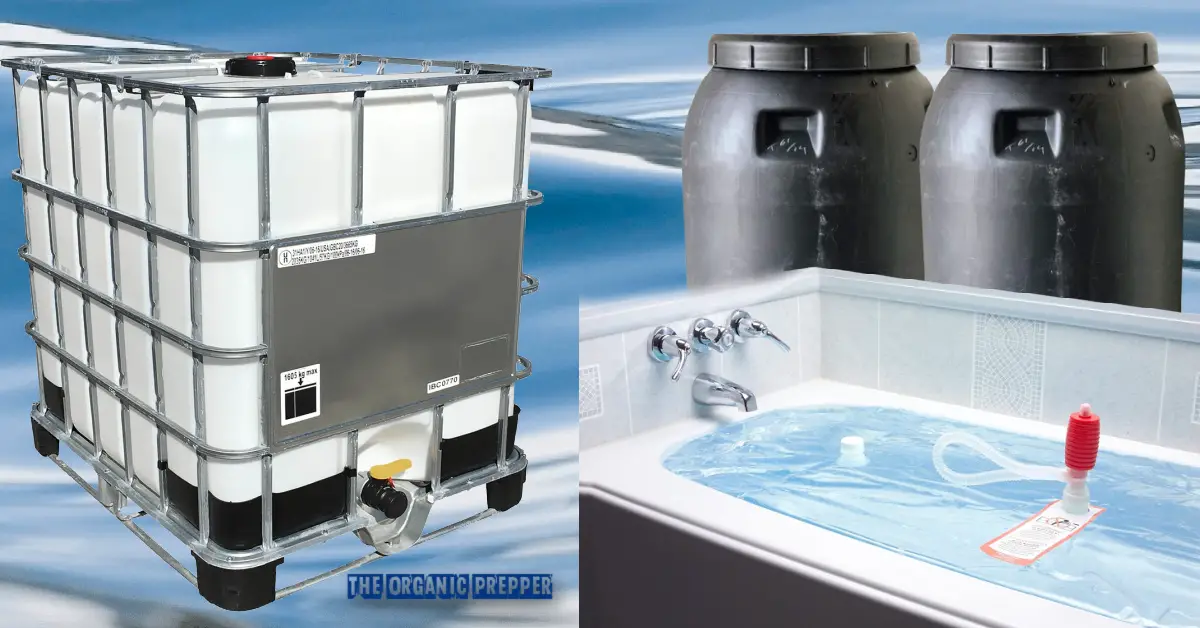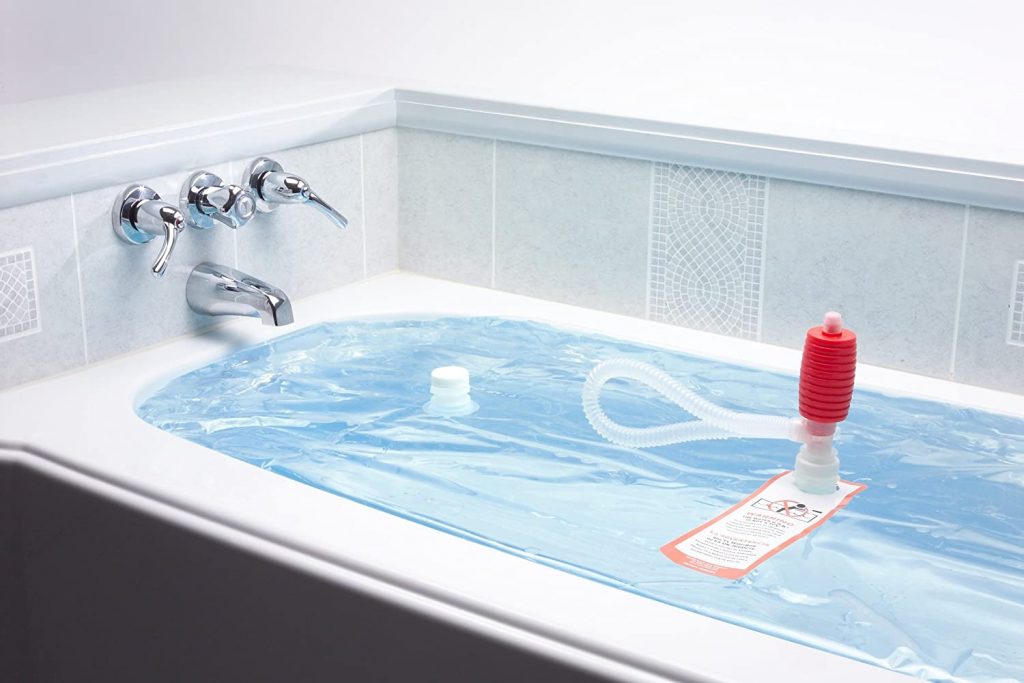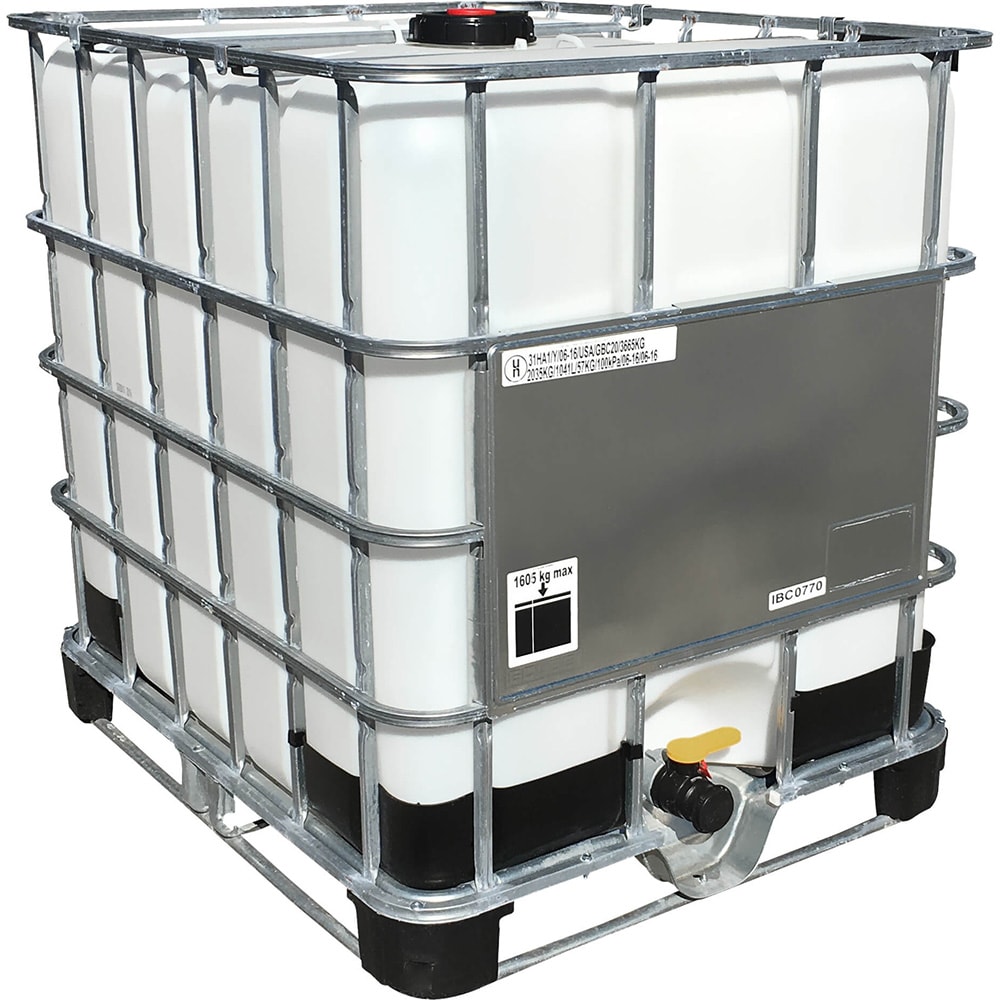(Psst: The FTC wants me to remind you that this website contains affiliate links. That means if you make a purchase from a link you click on, I might receive a small commission. This does not increase the price you’ll pay for that item nor does it decrease the awesomeness of the item. ~ Daisy)
by the author of The Prepper’s Water Survival Guide
and the online course, Build a Better Pantry on a Budget
One of the most common questions I get from folks who don’t live on a large property in a rural area is how to store a lot of water for a long-term emergency. First, let me give you a harsh reality check. If the crisis goes on long enough you will run out of stored water. So this is only a portion of your water preparedness plan. You also need to know how to acquire and filter more water. But that’s beyond the purview of this article.
Let’s talk about how to store a lot of water in a smaller space and how much water you need.
How much water do you need for emergencies?
There’s a “rule” that preppers often quote that suggests you need one gallon of water per person and pet per day in the event of emergencies. That is a decent basic guideline but there are other variables to consider too. Some pets, for example, certainly aren’t going to require an entire gallon of water while larger livestock will need more than a gallon on hot days.
This amount doesn’t take into consideration things like the climate, whether people will be doing strenuous work, or if certain health conditions are in play. It also doesn’t cover the water you’d need for personal hygiene, sanitation, or your garden. The best way to calculate how much water you truly need is to go without running water for a weekend and jot down every drop you use from your stash.
For more information on calculating how much water you’ll need for emergencies, check out this article and this one.
How to store a lot of water
Below, find some options for storing a significant amount of water.
Water Barrels
I live in an apartment building as of the writing of this article, and there isn’t a whole lot of extra space for water storage. I purchased a 65-gallon food-safe barrel for $15 from a lady on Facebook Marketplace. The barrel had initially held pickles long ago but she’d used it in her garden to collect rainwater for quite some time, so by the time it got to me, any residual pickle-y smell was long gone.
I keep it on my patio and opted for a color that blends in with the brick of my building. Nobody has paid any attention to it in the year and a half I’ve had it. The bonus to something like this is that I have a second top for it with a screen that I could use for water collection if things went really sideways.
To wash a barrel like this, if you don’t have a hose, visit a DIY car wash and bring your own dish soap. To fill it, I simply filled a 3-gallon container in my kitchen and walked it out until the barrel was full.
Mine doesn’t have any bells and whistles. I’d need to dip water out with a clean ladle if it came to using this for consumption. But if you have the money to do so, you can get “upcycled” water barrels on Amazon that have spigots and water catchment conversion kits delivered to your door within a couple of days. You can also pick up rain barrels at many local hardware stores. Just make sure it comes with a solid lid you can put on for storage and you’ll be all set.
Please note that water weighs 8.3 pounds per gallon. That means that my filled barrel weighs almost 540 pounds, not including the weight of the barrel. Be sure that the place you plan to keep your barrel can withstand the weight.
Bathtub water bladders
Another place you can store water in a smaller space is the bathtub. I suggest a Water Bob (100 gallons) or an Aqua Pod (65 gallons) for this. These are BPA-free plastic bladders that attach to the faucet of your tub to fill with water. Once the bladder is full, then you detach it from the faucet and put on the cap. This closed container keeps your water safe and free from contamination.
Obviously, you need to know the emergency is about to happen to use a bathtub water container. These are great if a storm is blowing up or some other type of crisis is imminent.
IBC Totes
Another option, if you have the space and an area that can hold around 2500 pounds, is a food-grade IBC Tote. These are large, 275-gallon plastic cubes that come in a metal cage for added support. They’re not cheap but you can sometimes find a reconditioned one. I kept a couple of these when I lived in California. The unit itself weighs around 150 pounds.
This company sells them new for about $400 at the time of publication.
Make absolutely sure that you look for one that is food-grade if you’re getting this to hold water for human consumption. The others are not made for potable water but might be fine for livestock or sanitation, assuming they haven’t held something toxic in the past. Be aware that many refurbished ones that are not food-grade have held things like fuel or antifreeze, and you should not use those for any survival water purposes.
I also recommend checking out the accessories for these and getting some spares. It would be a real shame to store that much water and not be able to access it due to a bad spigot.
A good place to store these is in a basement (if you have an entrance big enough), a garage, or a back patio. If you live someplace where the water might freeze, leave plenty of room for expansion.
How do you store large amounts of water?
Do you have a water strategy not mentioned here that would work in smaller spaces? Are you using any of these methods for water storage? Let’s talk about it in the comments section.
About Daisy
Daisy Luther is a coffee-swigging, adventure-seeking, globe-trotting blogger. She is the founder and publisher of three websites. 1) The Organic Prepper, which is about current events, preparedness, self-reliance, and the pursuit of liberty; 2) The Frugalite, a website with thrifty tips and solutions to help people get a handle on their personal finances without feeling deprived; and 3) PreppersDailyNews.com, an aggregate site where you can find links to all the most important news for those who wish to be prepared. Her work is widely republished across alternative media and she has appeared in many interviews.
Daisy is the best-selling author of 5 traditionally published books, 12 self-published books, and runs a small digital publishing company with PDF guides, printables, and courses at SelfRelianceand Survival.com You can find her on Facebook, Pinterest, Gab, MeWe, Parler, Instagram, and Twitter.


















